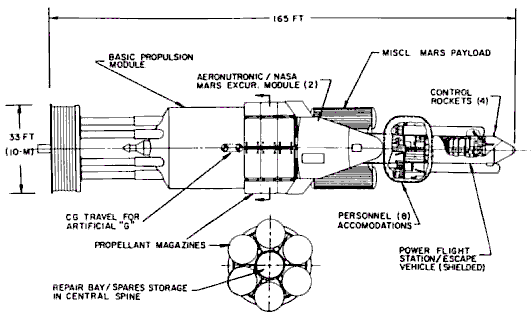
Home - Search - Browse - Alphabetic Index: 0- 1- 2- 3- 4- 5- 6- 7- 8- 9
A- B- C- D- E- F- G- H- I- J- K- L- M- N- O- P- Q- R- S- T- U- V- W- X- Y- Z
Orion OLV

Orion Mars Configura
Orion configured for Mars expedition.
Status: Cancelled 1965.
Zis is not nuts, zis is super-nuts
- Mathematician Richard Courant on viewing an Orion test
The nuclear pulse drive was conceived of H-bomb designers Stanislaw Ulam and Cornelius Everett at Los Alamos in 1955. Ted Taylor at Los Alamos further developed the concept. By the winter of 1957 Turner was working at General Atomics after developing the Triga small research reactor design with Freeman Dyson. Dyson managed to take a one-year sabbatical from his post at Princeton in order to work with Taylor on development of the nuclear pulse design at Los Alamos in 1958.
The nuclear pulse design, dubbed Orion, was a counter-intuitive approach to using the huge potential of nuclear energy for spacecraft propulsion without the costly development required for nuclear thermal or nuclear electric systems. Atomic bombs would be ejected aft of the rocket and exploded some distance away. Propellant (water or wax) surrounding the bombs would be transformed into high-energy plasma and bounce off a pusher plate at the rear of the rocket and push it forward. Shock absorbers would even out the ride. Although the plasma from the explosion would have a temperature of 80,000 deg K, the impulse would be brief and only a tiny layer of the ablative pusher plate would sublimate after each explosion. A method was developed of 'greasing' the plate between explosions to protect it.
Two shock absorber designs were explored. The first consisted of three donut-shaped gas-filled cushions, each one meter high, looking like a stack of tires. Six-meter high aluminum pistons rose from these absorbers. This system would limit peak G forces to 3 to 4 G's. But it would be a bumpy ride for the passengers. Therefore the second design was more complex but allowed the shock absorbers to operate in synchronization in order to further even out the G-forces. This would limit peak forces to 1.5 to 2.0 G's.
The design allowed vast payloads to be hurled to the planets. A typical design had a payload of hundreds of metric tons, meaning no high-tech environmental recycling systems or lightweight structures or equipment would be needed. The pusher plate was typically about one third of the weight of the craft. The General Atomics team saw themselves in the post-Sputnik period as in direct competition with Von Braun's chemical rockets. Dyson and the other believers thought they could land a huge manned expedition on Mars by 1964 and tour the moons of Saturn by 1970. Dyson particularly was anxious to bypass Mars and explore the moons of Jupiter and Saturn. They hoped to make these trips personally, in their lifetime.
Briane Dunne, the head of hardware development for the project, was less optimistic. He believed a practical design would not be ready until 2010-2050.
In the summer of 1959 Von Braun won the competition for selection of chemical or nuclear pulse rockets for use in the space program in the immediate future. The project was moved to the US Air Force, but the Air Force was not interested. Nevertheless the project struggled along for six years. Von Braun had enthusiasm for the design for use in Mars expeditions. A single launch of a Saturn V could orbit an Orion spacecraft that could take an expedition to Mars and back, whereas nuclear thermal or chemical designs would take 6 to 12. Therefore the General Atomics team later designed increasingly detailed but smaller and more limited designs for this approach. But Von Braun could not convince the NASA hierarchy of the scheme. It would put NASA in the position of arguing for an exception to the 1963 Nuclear Test Ban Treaty to allow firing of nuclear explosions in space. Finally funding was deleted entirely in 1965.
As a lark, at the end of the project, Dyson designed and published his theoretical designs for the ultimate nuclear pulse spacecraft - a starship. The pusher plate would be kilometers in diameter, and one megaton H-bombs would be ignited several kilometers behind the plate to propel it. Accelerations would be low, so the light structure would have to be built in space. Two versions were proposed, but even the faster model would only allow the grandchildren of the participants to reach Alpha Centauri.
Family: nuclear-powered, orbital launch vehicle. Country: USA. Launch Sites: Wallops Island, White Sands, Poker Flat, Andoya, Kiruna, Natal. Agency: General Atomic. Bibliography: 540.
Back to top of page
Home - Search - Browse - Alphabetic Index: 0- 1- 2- 3- 4- 5- 6- 7- 8- 9
A- B- C- D- E- F- G- H- I- J- K- L- M- N- O- P- Q- R- S- T- U- V- W- X- Y- Z
© 1997-2019 Mark Wade - Contact
© / Conditions for Use